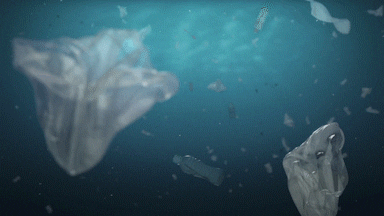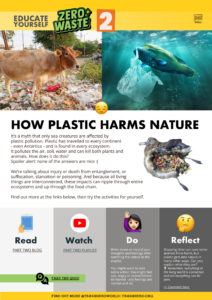Take a look at this:
Did any of the conversation in the video surprise you? Most people are only aware about sea creatures being harmed by plastic, but the reality is a lot worse. Let’s take a look.
HOW EXACTLY DOES PLASTIC HARM NATURE?

As we learned in the first part of our series, plastic is made from fossil fuels and chemicals – and it’s virtually indestructible in natural conditions. It’s exactly these characteristics that make it so dangerous for natural ecosystems and the life within them. Here are the five main ways plastic can harm the living world:
1. Entanglement: Plastic fishing nets, six-pack rings, and shopping bags are all common items that animals can get tangled up in – and there are many more. It’s often hard for them to escape and, aside from causing stress, it can make it difficult or impossible for them to swim, fly, or escape predators. Entanglement can also cause injuries or even death.
2. Ingestion: Many animals, such as sea turtles, birds, and fish, mistake plastic debris for food, either because it looks or smells like what they normally eat. A plastic bag floating underwater can look like a jellyfish, for example. And in the sea, plastic pieces get covered in algae and start to smell like small fish called krill. On land, especially in urban areas, there are other animals who scavenge for food, such as stray dogs, raccoons, monkeys and even elephants or camels. The food they find often gets eaten together with the plastic bags or packaging it comes in. When animals eat any kind of plastic, their digestive systems can get blocked, causing slow starvation. It can also lead to internal injuries and infections.

3. Chemical contamination: The harmful chemicals in plastics can leach out into the environment over time, as they are exposed to sunlight, water and other substances. These chemicals contaminate the water and soil. They can even start to build up in the tissues of animals that eat or come into contact with the plastic. Eventually this will lead to health problems or reproductive issues, as many of the chemicals in plastic affect how hormones function.
4. Habitat destruction: As well as contaminating the soil and water, plastic pollution can smother habitats such as coral reefs, seagrass beds, and wetlands. This suffocates the plant life, which in turn reduces the food and shelter for the various species that live there, leading to an imbalance in the ecosystem and a loss of biodiversity. Healthy ecosystems are essential for supporting human life and reducing climate change, as well as just being wondrous and beautiful parts of our planet.

5. Microplastic ingestion: Once in the environment, larger pieces of plastic break down into smaller fragments called microplastics. These enter the air, soil and water and get eaten or breathed in by a wide range of organisms, from plankton to whales. Microplastics can accumulate in the food chain, potentially reaching levels that can harm animals and humans.
In summary, we might say that plastic is a danger to the living world because it is both synthetic (not occurring in nature) and toxic (containing harmful chemicals). It cannot be broken down by natural processes.
Large pieces of plastic can stop living things and ecosystems from functioning properly from the outside by entangling or suffocating them. Large and small pieces of plastic can also cause damage from the inside either from physically blocking or injuring animals’ digestive systems or through chemical contamination of soil, water, air and living tissue.
To learn more about the impacts of plastics on nature and how they get into the environment in the first place, you’ll find lots of info in the reading / watch lists below. Take your time and check out whatever appeals to you. Some of the videos may feel a bit overwhelming, so take the time to record your thoughts in a journal or video diary – this helps to process any strong feelings. You can also test your knowledge in the quiz. And don’t forget to let us know your thoughts on this topic in the comments.
➤ How does plastic pollution affect marine life?
➤ The impacts of plastic pollution on animals
➤ What is Plasticosis? The new diseases found in seabirds
➤ How tiny plastic particles are polluting the land
❗ TRY THIS
Write down or record your thoughts and feelings after watching the videos in the playlist.
You might want to take some action. You might feel sad, angry or overwhelmed. Be honest – any feelings are normal and ok.
Could you explain your new knowledge to another person?
❓ OVER TO YOU
Stopping litter can save some animals from harm, but plastic gets into nature in many other ways (check out our watchlist). Can you explain what they are?
💡 Remember, everything in the living world is connected and not everything can be seen.
Give us your summary in the comments below!
Note: comments are moderated so they won’t appear right away



1 comment
Join the conversationElias - 28/12/2024
That is so sad see Section 1 entanglement